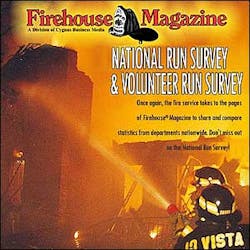National Run Survey: Busiest Hazmat, Ambulance Units of 2006
For the 26th year, the career fire service takes to the pages of Firehouse Magazine to share and compare statistics about company and department activity levels, funding, staffing and pay. A total of 244 fire departments took part in this year's survey, representing 45 states, the District of Columbia and 8 Canadian provinces.
The departments represented in this latest survey protect 79,994,388 people, and they have budgets totaling more than $12 billion. They provide this service with 4,095 engine companies, 1,489 ladder companies, 1,826 ambulances and numerous other specialized units.
They respond to 1,623,691 fire calls, 7,284,434 EMS calls and 10,757,152 total calls last year.
Kansas City Busiest Hazmat
Like they say; it's a dirty job, but someone's got to do it.
Kansas City, Mo. Hazmat 71 was ranked as the busiest hazmat unit in the United States by Firehouse Magazine in the 2006 National Run Survey statistics released earlier this month.
With 1,938 recorded runs in 2006, Kansas City was followed by Hazmat 19 in DeKalb County, Ga. (1,517) and Squad 3 and Hazmat 1 in Virginia Beach, Va. (1,012).
Hazmat Battalion Chief Donna Maize, who has held the position for a little over a year, talked about some of the usual responses.
"Of course a lot of it is fuel spill mitigation and response to suspicious packages," she said. "But Kansas City also is a major rail hub and there are a variety of different chemical facilities."
Maize said, however, that response to incidents to any of the chemical facilities is rare since a lot of them have their own hazmat staffs.
She added the large number of runs is "probably due to the size and geographic area that the unit covers.
Aside from the city's population of 500,000, Kansas City also responds to other areas in its vicinity.
"We do a lot of stuff that is regionally based, which might give us bigger numbers compared to other cities," Maize said. "There are 8 hazmat teams in our region" that provide support to each other, she said.
Hazmat Unit 71 is the only dedicated hazmat unit in Kansas City and is housed in Station 20; which it shares with Pumper 71.
According to the department's Web site, the hazmat unit was formed in 1989 following the tragic incident that claimed the lives of six firefighters from Pumpers 30 and 41.
Ten firefighters are assigned to each of the three shifts in the station with a minimum of eight working at one time. The hazmat unit requires a minimum of 5 hazmat members at once while the pumper requires one.
Staffs of both vehicles switch off month to month and work 24 hours on and 48 hours off, according to Maize.
Besides the hazmat unit and pumper, the station includes a utility vehicle and a foam tanker.
Within the station there also is Maize, an on-staff chemist, a training and equipment officer, an MMRS coordinator who works as a liaison with DHS and a secretary.
Through Kansas City's fire academy, recruits receive a 40 hour hazmat course. Maize, however, said that much more training occurs to prepare the department's hazmat members.
"To be assigned to the hazmat station, it is a seniority bid process," she said. "You have to be there for a minimum of three years" opposed to traditional positions in which the required stay is one year.
Maize said that the main focus recently has been put on coordinating the regional support system of hazmat units, which has been made possible by DHS grants. The department has worked with the Local Emergency Planning Committee (LEPC) and the Heart of American Fire Chiefs Association (HOA) on various initiatives, she said.
"A lot of it is dealing with making sure all of the teams have the same training and equipment."
Philadelphia Runs Busiest EMS
The Philadelphia EMS crew staffing M-2 was the busiest in the nation last year, answering 9,368 calls.
The sixth largest city in the country serves more than a million residents as well as workers and visitors. EMS crews in the City of Brotherly Love went out the door 214,404 times last year.
When someone dials 9-1-1, an emergency communications dispatcher gives the caller pre-arrival instructions, while another person alerts the proper crew.
"Our dispatchers are trained to give medical instructions to the person so they can assist the patient until the ambulance arrives," said Ernest Hargett, deputy commissioner of operations.
Many without insurance and those living below the poverty level, call 9-1-1 for a myriad of issues.
"We are often their entry way into the health care system," Hargett said.
Fire department personnel staff 36 ALS and nine BLS ambulances. In addition, engines and ladders are manned by firefighter/EMTs.
Depending on the nature of the call and the location of the closest EMS unit, engines and ladder crews are often dispatched to provide care. "It's often important to get help to a person immediately."
During Eagles and Phillies games, the city has a certain number of dedicated units. However, the stadium or venues also are required to hire non-municipal providers to assist.
"There is just no way we can handle those events as well as the regular calls."
As in most jurisdictions, the insurance company of the patient is billed if the person is transported. But, Hargett said no one is ever denied service.
"We don't turn anyone down. We're here to help. It doesn't matter."
Philadelphia has a number of trauma centers which contract with various helicopter services. Should a patient need the services of a specialty center, medics can call for aviation.
Hargett said he doesn't foresee the number of EMS calls going down anytime soon, especially with the number of people who depend on emergency rooms for their everyday health care needs.
